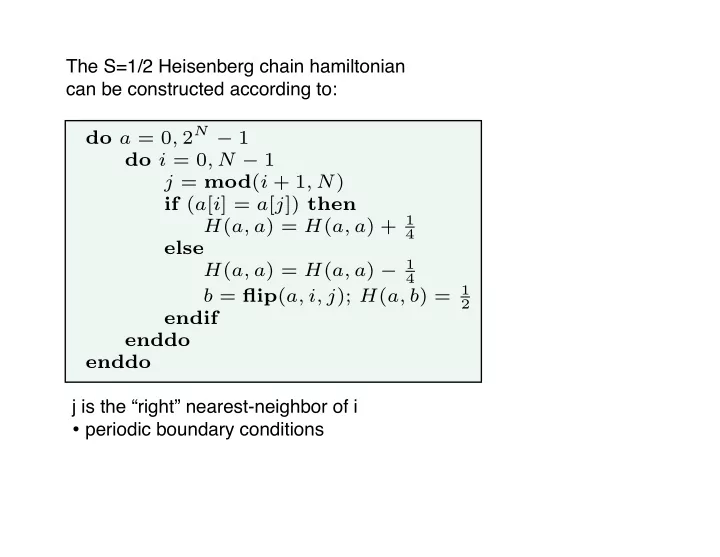

The S=1/2 Heisenberg chain hamiltonian can be constructed according to: do a = 0 , 2 N − 1 do i = 0 , N − 1 j = mod ( i + 1 , N ) if ( a [ i ] = a [ j ]) then H ( a, a ) = H ( a, a ) + 1 4 else H ( a, a ) = H ( a, a ) − 1 4 b = flip ( a, i, j ); H ( a, b ) = 1 2 endif enddo enddo j is the “right” nearest-neighbor of i • periodic boundary conditions
Diagonalizing the hamiltonian matrix • on the computer • gives the eigenvalues and eigenvectors If U is the matrix whose columns are the eigenvectors of H, then � n | A | n ⇥ = [ U T ∗ AU ] nn is the expectation value of some operator A in the n:th eigenstate Problem : Matrix size M=2 N becomes too large quickly • maximum number of spins in practice; N ≈ 20 • M 2 matrix elements to store, time to diagonalize ∝ M 3 Using conservation laws (symmetries) for block-diagonalization We can choose the basis in such a way that the H becomes block-diagonal H • the blocks can be diagonalized individually • we can reach larger N (but not much larger, N ≈ 50 is max)
Simplest example ; magnetization conservation N � S z m z = i i =1 • blocks correspond to fixed values of m z • no H matrix elements between states of different m z • A block is constructed by only including states with a given m z • corresponds to ordering the states in a particular way Number of states in the largest block (m z =0): N!/[(N/2)!] 2 k m z H Other symmetries (conserved quantum numbers) • can be used to further split the blocks • but more complicated • basis states have to be constructed to obey symmetries • e.g., momentum states (using translational invariance)
Pseudocode: using magnetization conservation Constructing the basis in the block of n ↑ spins ↑ Store state-integers in ordered list s a , a=1,....,M Example; N=4, n ↑ =2 s 1 =3 (0011) do s = 0 , 2 N − 1 s 2 =5 (0101) if ( P i s [ i ] = n ↑ ) then a = a + 1; s a = s endif enddo s 3 =6 (0110) M = a s 4 =9 (1001) s 5 =10 (1010) How to locate a state (given integer s) in the list? s 6 =12 (1100) • stored map s → a may be too big for s=0,...,2 N -1 • instead, we search the list s a (here simplest way) subroutine findstate ( s, b ) Finding the location b b min = 1; b max = M of a state-integer s in the list do • using bisection in the ordered list b = b min + ( b max − b min ) / 2 if ( s < s b ) then b max = b − 1 elseif ( s > s b ) then b min = b + 1 else exit endif enddo
Pseudocode; hamiltonian construction • recall: states labeled a=1,...,M • corresponding state-integers (bit representation) stored as s a • bit i, s a [i], corresponds to S zi loop over states do a = 1 , M do i = 0 , N − 1 loop over sites j = mod ( i + 1 , N ) check bits of state-integers if ( s a [ i ] = s a [ j ]) then H ( a, a ) = H ( a, a ) + 1 4 else H ( a, a ) = H ( a, a ) − 1 4 s = flip ( s a , i, j ) state with bits i and j flipped call findstate ( s, b ) H ( a, b ) = H ( a, b ) + 1 2 endif enddo enddo
Momentum states (translationally invariant systems) A periodic chain (ring), translationally invariant • the eigenstates have a momentum (crystal momentum ) k k = m 2 π T | n � = e ik | n � N , m = 0 , . . . , N − 1 , The operator T translates the state by one lattice spacing • for a spin basis state T | S z 1 , S z 2 , . . . , S z N � = | S z N , S z 1 , . . . , S z N − 1 � [T,H]=0 → momentum blocks of H • can use eigenstates of T with given k as basis A momentum state can be constructed from any representative state N − 1 1 � e − ikr T r | a � , | a � = | S z 1 , . . . , S z ⇤ N a | a ( k ) � = N � r =0 4-site examples Construct ordered list of representatives ( 0011 ) → (0110),(1100),(1001) If |a> and |b> are representatives, then ( 0101 ) → (1010) T r | a ⌃ ⇤ = | b ⌃ r ⇥ { 1 , . . . , N � 1 } Convention: the representative is the one corresponding to the smallest integer
Recommend
More recommend